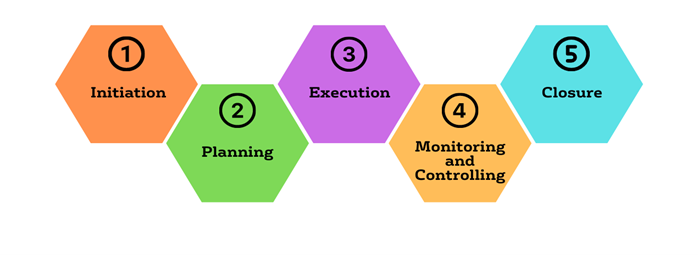As promised, this is the follow up from the University for Foreigners of Perugia for Dille2023 blog on Team coaching for project-based learning. (Read here if you missed it). This time we will focus on the Project Management phases and the basics of what goes into these phases. We will also discuss your role as a teacher-coach to ensure your project is successful.
So, what are these Project Management phases you ask? Well, they are Initiation, Planning, Execution, Monitor and Controlling and finally Closure. When going through these phases it is important not to focus on the result or the finished project, but to focus on the process of getting to that result and all the fun activities you can do along the way.
During the conference we talked about the phases briefly and as you read further, we will go into detail a little further.

First, we will start with Initiation. But before we do, I would like to highlight that this phase combined with Planning and Monitor and Controlling are important to the management of your project. This is because you are preparing your students and helping to guide them if the project is going off course.
During the initiation phase the students will already be collaborating and together discovering the teams’ vision, coming up with the purpose, creating team values and developing relationships within the team. This phase is important to establish guiding rules and having the students realizing their strengths and helping them understand where they can fit into the project.
This is the students first opportunity to learn to provide positive feedback, as well as understanding how to actively listen to their team members.
The next phase in project-based-learning is the planning phase. This is where the students decide on the roles and responsibilities, set their goals and then identify potential blockers. This is also the phase where students will set up progress checkpoints and create the time limits.
This is considered one of the most important phases, as students will learn how to hold themselves and each other accountable. This accountability starts with roles and responsibilities. The students can put value on the project by brainstorming and mind mapping and creating a plan that they all agree upon.
An example of this is the teams come up with two students looking for the pictures on the internet, one student writing about the picture, one student being the recorder and writing about the timeline of events and finally determine who will be the presenter and present the project to the class. They also can produce some potential blockers, such as, maybe the internet doesn’t work, someone is absent from class that day, and then come up with ways to lessen the problems that may arise.
What is important to remember that during these first two stages are that the students shouldn’t be thinking are or trying to start the project or perform the tasks to complete the objective, you are trying to set up and plan the project and not rushing to the execution or completion of the project.
Execution and Monitor and controlling are the phases where the students perform project tasks to reach the final objective. This is also where the can students provide feedback to each other and perform self/team assessments and make adjustments to keep the project on track. The teachers during this stage can use powerful questioning to guide the students and steer the teams in the right direction.
The final phase is closure. In this stage the students can finish any last minute revisions to the final project and practice the presentation. They can also print the final product or test the technology if using a video presentation.
This phase also includes self-reflection and this time students will use a self-assessment questionnaire to help them reflect on how they have done individually and as a team and understand how they could do better in future projects.
You could also narrow your students focus to one area, for instance, focusing on collaboration and reflecting on how their team performed and how they could be a better team member.
Remember that project-based learning using coaching techniques is a skill that will enrich your classroom environment both for you as a teacher and your students as team members. It will also foster a classroom filled with collaboration, 21 century skills and best of all, encourage a classroom with students that are empowered. You will be providing students with skills they can use outside the classroom.
If you have any questions or with to learn even more about these teaching skills. The course Your Students today…Leaders tomorrow – Coaching Techniques for Language Teachers to Enhance Teenagers’ 21st Century Competencies is just the class you are looking for and is now open for enrollment.
In this course you will put these skills into action and see firsthand how to use coaching techniques like using powerful questioning and providing positive feedback. So, SIGN UP today.

